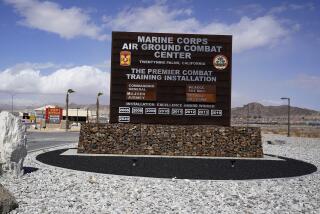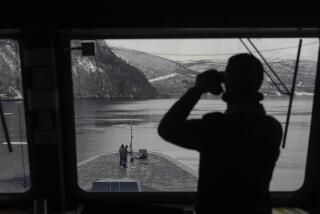War Games Not Just Make-Believe : Defense: U.S. Marines train near that other Bagdad, in the Mojave Desert. The fighting may be simulated but the purpose is deadly serious.
- Share via
TWENTYNINE PALMS, Calif. — Dawn was sneaking over a distant ridge, and 50 miles due south of Bagdad, Maj. Brian Robertson of the U.S. Marine Corps was crouching like a quarterback in a huddle, diagraming a play in the dust.
“What we’ve got up here is an enemy company dug in,” Robertson said. “A Soviet-style strong-point”--three trench lines protected by a forward machine gun emplacement.
Just the sort of defensive posture, Robertson said, that Saddam Hussein’s Soviet-trained army might employ--if this were not just a drill, if the American forces were 50 miles south of Baghdad, Iraq, not the isolated hamlet of Bagdad, Calif., on Interstate 40.
But it was the desert, and temperatures here would eventually climb to 106 degrees Tuesday. There were other important elements of reality in this little war game: the mortar shells, the machine gun fire, the M-16 rounds. No one would be shooting at the Marines--the enemy here was a phantom--but mistakes happen and “friendly fire” could prove deadly.
As American and Iraqi forces confront each other in the Persian Gulf, such “live-fire” desert warfare training at the massive Marine Air-Ground Combat Center at Twentynine Palms 150 miles east of Los Angeles is taking on a special urgency. Marine commanders say it is not quite as hot or nearly as humid as Saudi Arabia, where temperatures reached 108 in the capital, Riyadh, on Tuesday. But American commanders are counting on this Marine base that trains 50,000 troops each year as well as the Army’s Ft. Irwin as substitutes.
There is no substitute, military men say, for actual combat. Live-fire drills, with their inherent dangers, at least provide some semblance of the life-or-death tension of battle, Marine commanders said.
“Combat is chaotic, so we train for chaos,” said Col. John Moffett, a 24-year veteran who served two tours in Vietnam and oversaw Tuesday’s drills. “So we try to create chaos--the smells, the noise, the explosions.”
Troops also train in “force-on-force” exercises--a war game in which they shoot blanks and use infrared lasers and special jackets, and where “kills” are noted by the sound of a beeper. But live-fire, Moffett said, has a deeper “psychological edge. . . . You don’t want to create a friendly casualty.”
So 120 members of Capt. Rob McLenagan’s G Company moved out at dawn, disappearing in shallow ravines as they silently neared the enemy stronghold, one platoon covering another. Tactical specialists such as Robertson followed the units, choreographing a battle that couldn’t be lost.
The first mortar rounds echoed off a ridgeline. From the start, there were problems. The mortar was off target, and a cease-fire was ordered because shells were falling too close to the advancing Marines.
Adjustments were made, and before long the Marines had taken out the machine gun nest and set up their own machine guns to cover their assault. Robertson and other observers would describe counterattacks while tossing “flash-bang” grenades to simulate incoming fire. Grenade launchers shot orange smoke bombs amid the explosions, machine gun fire and rifle blasts.
G Company broke through a breach in a mine field and accomplished its objectives--but not without suffering some phantom casualties.
If a man screwed up, Moffett explained, he might be tapped on the shoulder and informed he was dead. But in this battle, anyway, they would come back to life.
A dead Marine, the colonel explained, won’t get enough training.
More to Read
Sign up for Essential California
The most important California stories and recommendations in your inbox every morning.
You may occasionally receive promotional content from the Los Angeles Times.










